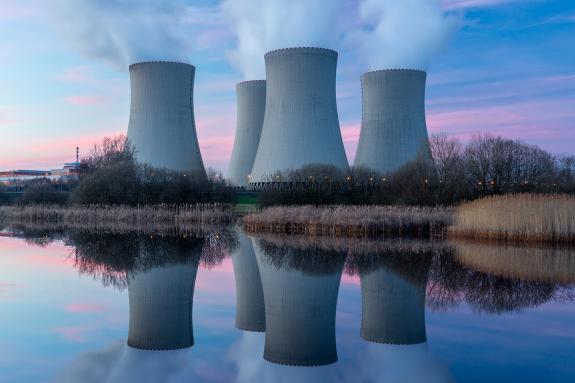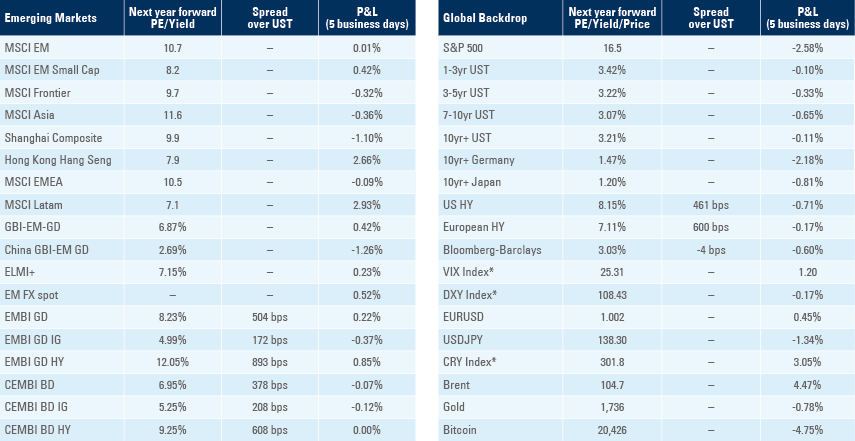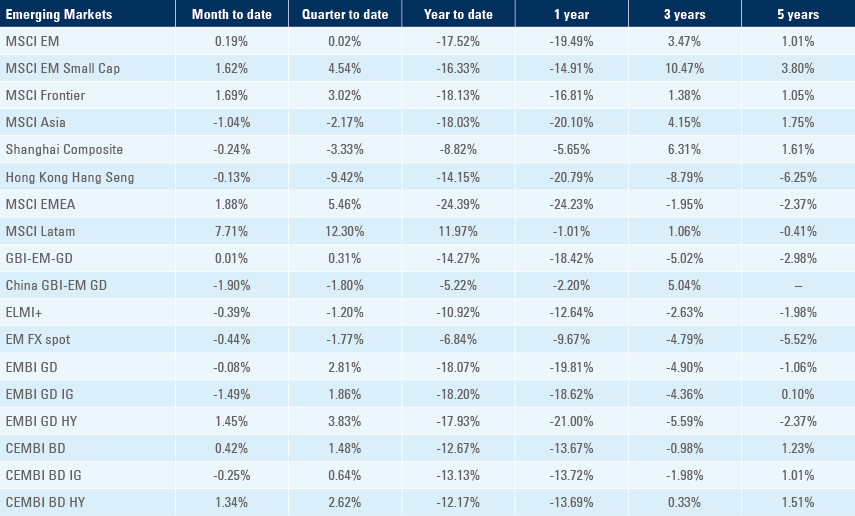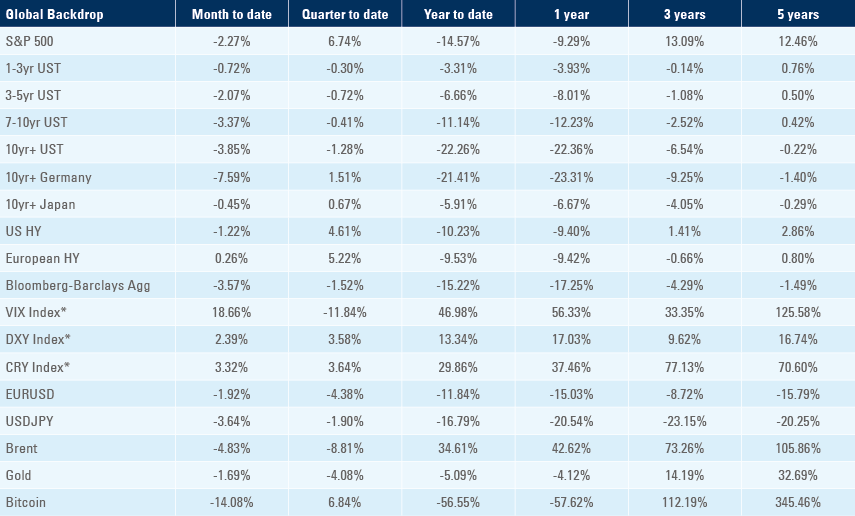
Energy politics move again to the fore, while concerns about Ukraine’s nuclear power plant force rare agreement between Russia and Ukraine. Argentina posts good fiscal numbers and looks at its exchange rate. Brazil’s presidential election heats up as debates between the candidates begin. China announces a new package of economic support measures. Pakistan receives IMF support amid nationwide floods. Egypt gets closer to a new IMF deal. Powell vows to ‘keep at it’ in Jackson hole but gets no help from the White House.

Geopolitics
On the anniversary of its independence in August 1991, Ukraine received a large funding grant from the US worth USD 3bn, which is part of the USD 9.5bn in budget funding promised by the US, of which grants represent USD 8.5bn. Following negotiations between Russia, Ukraine and the UN, a mission made up of officials of the International Atomic Energy Agency (IAEA) was allowed to travel to the Zaporizhzhia nuclear power plant in south eastern Ukraine this week, to assess the situation as shelling around the plant continues, risking a nuclear accident.
Commodities
Commodity prices were firm last week, helped by crude oil prices, as Saudi Arabia suddenly flagged the possibility of production cuts should a deal between the US and Iran lead to a marked increase in Iranian crude oil reaching the market.
Meanwhile, negotiations with Iran continued to make progress. Both the US and Iran have responded to the European Union’s ‘final offer’ for the revival of the 2015 nuclear deal (JCPOA), laid out by the EU in early August. Concessions have been made by both sides: the US offered guarantees in case of a change in leadership in the US, and Iran dropped demands regarding their Revolutionary Guards. Now Iran's President Raisi and his nuclear chief said that an IAEA probe into Iran’s past nuclear activities (pre-2003) must be closed before an agreement is reached. A deal would see Iran get immediate access to USD 7bn in frozen bank accounts, and the right to market 50 million barrels of crude oil within 60 days, which are currently held in storage.
The energy crisis continued to rage in Europe, with natural gas prices and electricity prices soaring further during the past week. Spot and forward prices in the reference Dutch TTF natural gas market have roughly doubled to €300 per MWh since the start of the quarter. This increase has happened while German natural gas storage facilities, which can see the country through the winter, are already 80% filled up, indicating that the market is concerned about future supplies into next year and not simply immediate power shortages.
This is having ripple effects on the pricing of power across Europe. In the German wholesale electricity market, the day-ahead base price more than doubled to €620/MWh since the start of the quarter. Forward prices for the winter months have soared to double that rate. Faced with grave economic and political consequences, European policymakers are now working to reform the competitive European energy market put in place over the past two decades, so that prices are no longer coupled to the most expensive supplier. Under the current system, producers with lower costs such as wind or solar are paid the same as those with higher costs such as operators of gas-fired power plants. “We are working hard to find a new market model”, said German Economy Minister Robert Habeck, whose comments were echoed by Commission head Van der Leyen. An increasing number of member states are calling for a price cap, and Czechia, which holds the rotating presidency of the EU, will convene an extraordinary meeting of energy ministers on September 9.
Emerging markets
Argentina: Fiscal accounts surprised positively, putting Argentina on track to meet the 2.5% deficit target agreed with the IMF earlier this year. Conversely, trade data has been deteriorating. Government revenues for July rose 83% yoy, comfortably above the 71% inflation number for the same period. Nominal primary spending (before interest expenditures) rose by 62%. As a result, the primary balance for July was flat, and the primary balance for the Jan-July period was a modest 1% of GDP. Energy subsidies continue to increase at a greater pace than inflation, but transportation subsidies have been curtailed. Also, the monthly Economic Activity Estimator Index (EMAE) showed a higher-than-expected expansion of 1.1% m/m (6.4% yoy) in June.
Disappointingly, the trade balance for July came in at USD -437m, the second consecutive monthly deficit. This is due to the rapid increase in the cost of energy imports, but also due to a decrease in exports volumes reflecting the expensive level of the official exchange rate, which penalises exporters. Economy minister Massa and his team have been in discussions with agricultural exporters’ representatives to accelerate grain exports and release US dollars into the system, but the conversations have not yet borne fruit. Last week, economic circles were roiled by rumours of a plan to (a) devalue the peso by 50% on September 1, (b) split the exchange rate and (c) introduce radical fiscal spending cuts. The vice minister for the economy Gabriel Rubinstein denied that such plans came from his office, and Massa also dissociated himself from such measures. This week Massa will travel to Washington, DC to hold meetings with the IMF and the US Treasury.
The prosecutor's office requested a 12-year jail sentence for Vice President Cristina Kirchner (CFK) on alleged corruption charges in public works. A panel of judges is expected to rule on this case later in the year. If convicted, a long appeal period will begin. Throughout this time, Cristina will remain free and without any restriction on running for any office in the country.
Brazil: Several weeks after the end of a strike, the Central Bank released economic data for both April and May. The current account deficit (CAD) reached USD 3.5bn, which was higher than expected but was easily covered by Foreign Direct Investment (FDI) that came in at USD 4.5bn for the same period, bringing the total 12-month total to USD 60.0bn, or 3.5% of GDP. The IPCA-15 inflation print released mid-month in August confirmed the downward trend in the previous FGV release, falling by 0.73% m/m vs. a 0.13% m/m increase in July. The yoy inflation number came down to 9.60%. The market consensus has the yoy number fall further to 6.8% by year-end.
In one of the key moments of the current presidential campaign, former President Lula da Silva and incumbent Bolsonaro had their first in-person confrontation in a televised debate that set the tone of the contest, with five weeks to go. The two front-runners attacked each other (Bolsonaro branding Lula’s government “the most corrupt in history”), while Ciro Gomes and Simone Tebet, the two other presidential candidates sharing the stage, also focused most of their attacks on Bolsonaro. The latest polls released on August 29th show Lula ahead of Bolsonaro at 43% vs. 36% in the first round, and Lula winning by 52% to 39% in a run-off between the two of them, a difference that has been narrowing down at a slow pace.
Chile: Despite the economy having stalled in Q2, Chile’s current account deficit surprised to the downside at USD -6.6 bn vs. USD -4.4 bn expected. This will not be lost on the central bank as they gather again to set monetary policy on September 6. Two days earlier, on September 4, the long-awaited plebiscite on the new constitutional proposal will occur. The polls have consistently shown a 10 points advantage for those ‘opposed’ to the new constitution (46%) vs. those ‘in favour’ (37% in the most recent polls), while 17% are undecided, so the proposal will likely be rejected, which the market is expected to welcome as it means that the current constitution remains in place.
Mexico: Q2 GDP growth was 0.9% q/q, non-annualised, slightly below expectations of 1.0%. Over the same period, the Q2 current account showed a small deficit of USD 0.7bn, mainly attributed to a drop in the trade balance following lower oil exports revenues. The trade deficit for July alone was USD 6bn, and the total trade balance for the January-July period saw imports expand by 23.7% yoy, while exports grew only 18% yoy. Headline inflation came at 0.42% sequentially during first half of August, above consensus of 0.36%, driven by higher-than-expected core inflation, particularly food related goods (0.83%). Annual headline inflation reached 8.62% yoy from 8.14% in the previous report, while core rose to 7.97% yoy from 7.75% yoy. The minutes of the July Banxico MPC suggested that the central bank might moderate the pace of rate hikes. The market is pricing in c. 140bps of rate hikes over the next six months, after which some rate cuts are priced in.
China: The government announced further financial stimulus measures as questions remain about whether previously announced measures are sufficient to revive the property market. In response to July’s nationwide mortgage boycott, a number of additional measures were announced including a reduction in the down payment for second homes, a cut in official lending rates and the creation of a fund to help underwrite the completion of exiting projects. Following the earlier rate cut by the PBOC, this week the State Council announced a new round of economic stimulus measures, including another 300 billion yuan (0.25% of GDP) in policy bank financing to support major infrastructure projects, 500 billion yuan (0.41% of GDP) in additional local government special bonds, and 200 billion yuan special bond (0.16% of GDP) by state-run power generation corporations to ensure a stable power supply. China’s National Party Congress, held every five years, will be held prior to year-end, but the actual date is not usually known until two months prior to the event. The market expects the Congress to be held sometime in October, so much attention is focused on when the announcement will be made. President Xi will be going for an unprecedented third five-year term.
Korea: The Bank of Korea (BoK) hiked its policy rate by 25bps to 2.50%, reverting to a more gradual pace of adjustments after its 50bps move in July. The BoK raised its 2022 CPI inflation forecast to 5.2% from 4.5% and indicated that “CPI will remain high at above 6% for some time.” Importantly, the 20-day exports number for August came in at 3.9 % yoy in August vs 14.5 % in July, pushing the 20-day trade balance deficit wider to USD 10bn.
Taiwan: Taiwan’s July export orders were significantly weaker than expected, indicating weak final demand from China, the EU and the US. The build-up in the Taiwanese manufacturing sector’s inventory levels is a cause for concern, seeing that the manufacturing PMI number has already been on a downward trajectory to 44.6 last month.
Pakistan: Tens of millions of people across large swathes of Pakistan have been battling the worst monsoon floods in a decade. The Met Office said the country as a whole had received twice the usual monsoon rainfall, but Balochistan and Sindh provinces had more than four times the average rainfall of the last three decades. The crisis has affected all four of the country's provinces. Faced with such challenging circumstances at home, the government could at least cheer the approval by the IMF Executive Board of the staff-level agreement reached in July. The approval releases USD 1.6bn in funds to Pakistan under the terms of the current EFF (Extended Fund Facility) programme, bringing total disbursements to USD 4.2bn since 2019. This rewards the government’s commitment to IMF-mandated reforms, such as lower subsidies and a tighter fiscal deficit target, which will help reduce the country’s external funding need. Pakistan also secured USD 4 billion in financing from Saudi Arabia, the UAE, and Qatar in the form of deposits and investments that shore up FX liquidity.
Egypt: GDP growth for FY22 ending in June recovered to 6.6%, up from 3.3% in FY21, helped notably by tourism receipts near record highs. The country has been in negotiations with the IMF on a new financial support package and has already delivered on some of the IMF demands, including a first devaluation in April. Prime Minister Madbouly informed market participants last week that the talks are progressing and are in their final stage, following important changes to the country’s economic team, including the central bank governor. Although the IMF is not asking for cuts in food price subsidies, according to the Minister of Finance, but is taking issues with the subsidised interest rates available to certain sectors such as tourism and real estate financing, which undermine the effectiveness of monetary policy.
Snippets
- South Africa: Headline CPI accelerated to 7.8% yoy in July from 7.4% in June, in line with consensus estimates. Meanwhile, core inflation increased to 4.6% yoy from 4.4% (consensus: 4.5%), in a further sign that price pressures are starting to broaden in the economy. Fuel and food inflation remained the main drivers of higher price growth. Fuel prices were up by 9.4% m/m, taking the annual increase to 56% yoy from 45% in May. Food inflation increased to a double-digit pace in July (10.1% yoy).
- Indonesia: Bank Indonesia (BI) surprised with a 25bps rate hike, bringing the policy rate to 3.75%. The hike came earlier than expected as BI Governor Perry Warjiyo was quite dovish in recent weeks. The central bank explained that the change was due to the rise in core inflation: BI now expects core inflation to rise to about 4.15% yoy by the end of this year, slightly above their 2-4% target range. Governor Warjiyo highlighted that the central bank had detected increased pass-through or second-round effects into core inflation.
- Nigeria: The Nigerian economy recorded a real GDP growth of 3.5% over the previous year in Q2, above consensus estimates of 2.9%. The non-oil economy contributed positively to economic growth, rising by 4.8% yoy during the period while the oil sector contracted for the ninth consecutive quarter (-12%oya in 2Q, or -5% q/q).
- Peru: Q2 GDP growth came in above expectations with a positive sequential rate of 1.0% (saar), following a 2.0% contraction in 1Q22.
- Turkey: The foreign trade deficit came in at USD 10.7bn in July, as imports rose by 41% yoy and exports grew by a mere 13% yoy. In the first seven months of the year the deficit has risen by 143% over the previous year, to USD 62.2bn.
- Angola: The Popular Movement for the Liberation of Angola, or MPLA, the ruling party since 1975, won the presidential election with 51.2% of the vote. This narrow victory nevertheless grants President Lourenco a second term in office, with a solid majority of 124 (out of 220) seats in the National Assembly.
Developed markets
United States: In a much-awaited speech at the annual Kansas Fed symposium in Jackson Hole, Fed Chairman Jay Powell had an opportunity to address monetary policy ahead of the September 21 FOMC meeting. He used his short speech to correct the (mis?)-perception he may have caused at the last FOMC, that Fed Funds rates were somehow getting close to neutral. This new take was more in line with a number of Fed speakers who have offered hawkish comments in recent weeks. He went further than that, by warning of ‘some pain to households and companies,’ thereby acknowledging how the Fed must break some things (unemployment) to fix others (inflation). More than simply the magnitude of the hiking cycle that lays ahead of us, Powell conveyed how long this fight might last, and sought to burnish his hawkish credentials by repeating that the Fed would ‘keep at it’ to get the job done, a direct reference to Paul Volcker’s 2018 memoir called ‘Keeping at it.’
Last week President Biden decided to go ahead with a plan to forgive student loans for borrowers earning less than USD 125k. The amount of loans forgiven vary between USD10k and USD20k, and 43 million Americans are eligible according to the department of Education. The policy may create a short-term boost to consumer confidence and will be well received by the Democrats’ electoral base just ahead of the mid-terms, but it may encourage household spending precisely when the Fed is trying to go the other way and correct excessive demand.
Meanwhile, US economic data was firm: on the positive side, the headline PCE price index fell 0.1% last month vs. 0.0% expected, taking yoy PCE down to 6.3% from 6.8%. The core PCE also fell yoy to 4.6% from 4.8%. The Michigan sentiment index rose again from record lows to 58.2, and inflation expectations fell slightly to 4.8% from 5.0% (1-year expectation), and to 2.9% from 3.0% (10-year). On the negative side however, the Manufacturing PMI came in below expectations at 51.3 (52.2 previous), while the Services PMI gauge was particularly weak at 44.1 (47.3 previous) New home sales fell 12.6% m/m in July, to 511k new homes, the lowest number since 2016.
Europe: Amid all the gloom and pessimism about the energy situation in Europe, economic data has been more resilient than expected and the Citi economic surprise index for the eurozone jumped by 20 points over the week to -32. The eurozone manufacturing PMI index was nearly unchanged in August at 49.7 vs. 49.0 expected. Both France’s business confidence index and Germany’s IFO expectations index were unchanged in August, beating consensus expectations. The first inflation data releases suggest that inflation is coming down sequentially, although it is still increasing on a yoy basis. The market has taken on board a series of hawkish remarks by eurozone policymakers and is now split between a 50bps and a 75bps rate hike at the next ECB meeting on September 8.

